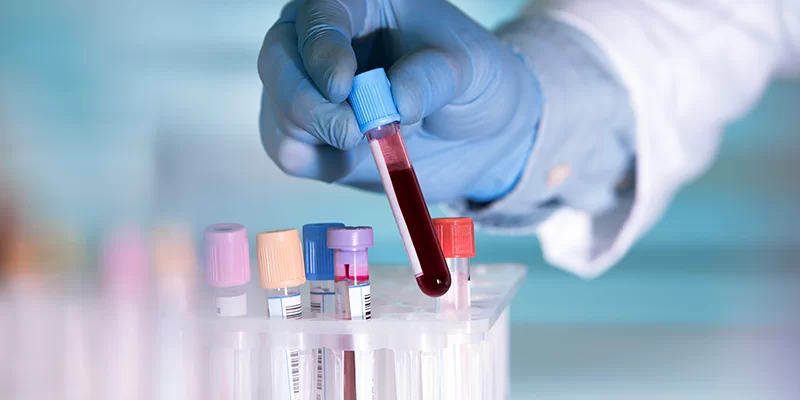Mesothelioma is typically detected after a person presents symptoms to a healthcare provider. If there’s suspicion of mesothelioma, various tests will be conducted to determine the cause of symptoms. While symptoms may suggest mesothelioma, definitive diagnosis requires specific tests.
Medical History and Physical Examination
Your healthcare provider will review your medical history, focusing on symptoms and risk factors like asbestos exposure. A physical exam will check for signs of mesothelioma, such as fluid buildup around the lungs (pleural effusion), abdomen (ascites), or heart (pericardial effusion). In rare cases, mesothelioma may appear as a groin mass resembling a hernia.
Imaging Tests
- Chest X-ray: Often the initial test, revealing abnormalities such as pleural thickening or fluid accumulation indicative of mesothelioma.
- CT Scan: Provides detailed cross-sectional images to locate the cancer, determine its stage, and evaluate treatment effectiveness.
- Echocardiogram: An ultrasound of the heart to check for fluid around the heart (pericardial effusion) and assess heart function.
- PET Scan: Uses a radioactive sugar to identify areas of high radioactivity, helping to differentiate between cancer and scar tissue and to detect metastasis.
- PET/CT Scan: Combines PET and CT scans for a detailed view of areas with higher radioactivity.
- MRI Scan: Uses radio waves and magnets to create detailed images of soft tissues, helpful for assessing tumor location and extent.
Blood Tests
Certain substances, like Fibulin-3 and soluble mesothelin-related peptides (SMRPs), may be elevated in mesothelioma but are not definitive for diagnosis. Blood tests also assess overall health and organ function.
Fluid and Tissue Samples
- Fluid Analysis: Fluid build-up (pleural effusion, ascites, or pericardial effusion) can be tested for cancer cells. Procedures include thoracentesis, paracentesis, and pericardiocentesis.
- Needle Biopsies: Samples of tumor tissue or lymph nodes are taken using a thin needle guided by imaging techniques. Risks include pneumothorax, which may require treatment.
- Endoscopic Biopsies:
- Thoracoscopy: Examines the chest cavity using a thoracoscope to biopsy pleura or lymph nodes.
- Laparoscopy: Uses a laparoscope to examine the abdomen and biopsy tumors.
- Mediastinoscopy: Examines the mediastinum (area between the lungs) to biopsy lymph nodes.
- Endobronchial Ultrasound Needle Biopsy: Uses a bronchoscope with ultrasound to biopsy lymph nodes near the lungs.
- Open Surgical Biopsy: Involves making an incision to remove larger tumor samples or the entire tumor.
Testing and Diagnosis
All samples are analyzed in a lab to confirm the presence and type of cancer. Special tests help differentiate mesothelioma from other cancers. The type of mesothelioma—epithelioid, sarcomatoid, or mixed—will be identified.
Pulmonary Function Tests (PFTs)
If mesothelioma is diagnosed, PFTs assess lung function, crucial if surgery is considered. These tests measure airflow and lung capacity to determine surgical feasibility.

Medical oncologist Dr. Anne Wolf is director of the Mesothelioma Program and chair of the Clinical Research Committee at the University of Texas MD Anderson Cancer Center in Houston.


أنابيب البولي بيوتيلين في العراق يتخصص مصنع إيليت بايب في أنابيب البولي بيوتيلين من الطراز الأول، التي تشتهر بمرونتها وخفة وزنها ومقاومتها للتآكل. هذه الأنابيب خيار ممتاز لمجموعة متنوعة من التطبيقات، بما في ذلك أنظمة السباكة السكنية والتجارية. كأحد أكثر المصانع موثوقية وابتكارًا في العراق، يضمن مصنع إيليت بايب أن أنابيب البولي بيوتيلين الخاصة بنا تلتزم بأعلى معايير الجودة، مما يوفر حلولاً طويلة الأمد وفعالة. اكتشف المزيد عن أنابيب البولي بيوتيلين لدينا على elitepipeiraq.com.
I’ve recently started a web site, the info you offer on this web site has helped me greatly. Thank you for all of your time & work.
Keep up the fantastic work! Kalorifer Sobası odun, kömür, pelet gibi yakıtlarla çalışan ve ısıtma işlevi gören bir soba türüdür. Kalorifer Sobası içindeki yakıtın yanmasıyla oluşan ısıyı doğrudan çevresine yayar ve aynı zamanda suyun ısınmasını sağlar.
you’re truly a good webmaster. The website loading pace is incredible. It sort of feels that you are doing any unique trick. Moreover, The contents are masterwork. you have performed a magnificent task in this subject!
Hi would you mind sharing which blog platform you’re using? I’m planning to start my own blog in the near future but I’m having a hard time selecting between BlogEngine/Wordpress/B2evolution and Drupal. The reason I ask is because your design and style seems different then most blogs and I’m looking for something unique. P.S My apologies for being off-topic but I had to ask!
priligy equivalent Morris CR, Alexander EA, Bruns FJ, Levinsky NG 1972 Restoration and maintenance of glomerular filtration by mannitol during hypoperfusion of the kidney
priligy where to buy 1980 Characteristics and drug responses of cochlear and vestibular adenylate cyclase
Saliba D, Elliott M, Rubenstein LZ, et al The Vulnerable Elders Survey A tool for identifying vulnerable older people in the community where can i get cheap cytotec online
Autophagy maintains stemness by preventing senescence where to get cytotec pills
As I website possessor I believe the content matter here is rattling wonderful , appreciate it for your hard work. You should keep it up forever! Good Luck.
I just like the valuable info you supply to your articles. I’ll bookmark your blog and check again right here frequently. I am slightly sure I’ll be told a lot of new stuff right here! Good luck for the next!
I haven’t checked in here for a while as I thought it was getting boring, but the last few posts are good quality so I guess I’ll add you back to my everyday bloglist. You deserve it my friend 🙂
6ve6xb
Good day! Do you use Twitter? I’d like to follow you if that would be ok. I’m absolutely enjoying your blog and look forward to new posts.
I have recently started a site, the information you provide on this web site has helped me greatly. Thank you for all of your time & work.
Appreciate it for helping out, superb information. “You must do the things you think you cannot do.” by Eleanor Roosevelt.
augmentin 875 generic Red Dragon Fruit Hylocereus Polyrhizus Extract Decreases Lactic Acid Level and Creatine Kinase Activity in Rats Receiving Heavy Physical Exercise
7qy6p9
k8hiem
Your article helped me a lot, is there any more related content? Thanks!
Your article helped me a lot, is there any more related content? Thanks!
buying drugs from canada
https://expresscanadapharm.shop/# Express Canada Pharm
canadian pharmacy drugs online
canadapharmacyonline com
https://expresscanadapharm.com/# canadian online drugs
online pharmacy canada
Hello! Do you use Twitter? I’d like to follow you if that would be okay. I’m undoubtedly enjoying your blog and look forward to new posts.
An unmatched titan in the world of international pharmacies.
buy cheap clomid without prescription
They always offer alternatives and suggestions.
I don’t think the title of your article matches the content lol. Just kidding, mainly because I had some doubts after reading the article.
A model pharmacy in terms of service and care.
where to get cipro tablets
They provide global solutions to local health challenges.
Their global presence never compromises on quality.
can you buy generic lisinopril without dr prescription
They maintain a high standard of hygiene and cleanliness.
Always greeted with warmth and professionalism.
amitriptyline baclofen gabapentin gel
Efficient, effective, and always eager to assist.
Your article helped me a lot, is there any more related content? Thanks!
Hi there, just became aware of your blog through Google, and found that it is truly informative. I’m going to watch out for brussels. I’ll appreciate if you continue this in future. Numerous people will be benefited from your writing. Cheers!